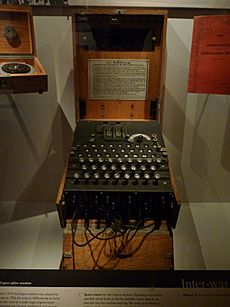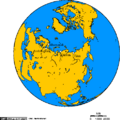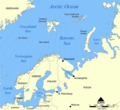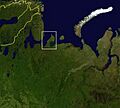Convoy PQ 18 facts for kids
Quick facts for kids Convoy PQ 18 |
|||||||
|---|---|---|---|---|---|---|---|
| Part of Arctic naval operations of the Second World War | |||||||
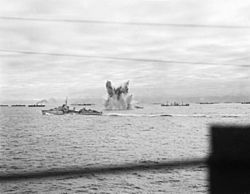 A depth-charge explosion near Convoy PQ 18 |
|||||||
|
|||||||
| Belligerents | |||||||
| Commanders and leaders | |||||||
| Strength | |||||||
| 40 merchant ships 40–50 escort ships 2 submarines 1 escort carrier (12 fighters, 3 reconnaissance aircraft) |
12 U-boats 92 torpedo-bombers 120 bombers long-range reconnaissance aircraft |
||||||
| Casualties and losses | |||||||
| 550+ survivors rescued 13 merchant ships 4 Sea Hurricane fighters |
4 U-boats, 22–44 aircraft | ||||||
| A Sea Hurricane was washed overboard | |||||||
Convoy PQ 18 was a group of forty Allied supply ships. They sailed from Scotland and Iceland to Arkhangelsk in the Soviet Union. This journey happened during World War II as part of the fight against Nazi Germany. The convoy left Scotland on September 2, 1942. It arrived in Arkhangelsk on September 21.
The Royal Navy provided many escort ships for this convoy. For the first time, an escort aircraft carrier, HMS Avenger, joined an Arctic convoy. This carrier brought fighter planes to protect the ships. British code-breakers at Bletchley Park helped by providing secret information. They knew about German plans from decoded messages.
The Germans also had their own code-breaking service, called B-Dienst. They read some British signals. The German air force (Luftwaffe) and navy (Kriegsmarine) prepared a huge attack. From September 12 to 21, Convoy PQ 18 faced attacks. Bombers, torpedo-bombers, and U-boats (submarines) attacked the convoy.
Thirteen merchant ships were sunk. However, the Allies fought back hard. They destroyed four U-boats and between 22 and 44 German aircraft. The escort ships and planes from Avenger defended the convoy. They used intelligence to avoid U-boats and get early warnings of air attacks. Gunners on the merchant ships also helped. They fired anti-aircraft guns and used barrage balloons.
The convoy reached Arkhangelsk on September 21. Some ships ran aground in a storm but were later saved. Unloading all the supplies took about a month. This battle was very costly for the Germans. They could not repeat such a large attack later in the war.
Contents
Why Were Arctic Convoys Important?
Sending Supplies to Russia
In October 1941, Winston Churchill, the British Prime Minister, promised to send supplies to the Soviet Union. This was after Germany invaded the USSR. The goal was to send a convoy every ten days. They aimed to deliver many tanks and aircraft. These supplies were vital for the Soviet war effort.
Ships from Britain and the United States gathered in Iceland. This was a good meeting point for ships from both sides of the Atlantic. By late 1941, a system for convoys was in place. A convoy commodore led the merchant ships. This person was usually a retired naval officer. They helped keep the ships in formation.
More Protection for Convoys
After some difficult convoys, especially Convoy PQ 17, Arctic convoys were paused. Admiral John Tovey decided that convoys needed more protection. He wanted more destroyers to fight German surface ships.
A new escort carrier, HMS Avenger, joined the escort force. This ship could launch planes to protect the convoy from the air. This was a big help. The convoy also sailed further north to avoid German bases. This made the journey longer but safer from some threats.
Secret Intelligence and Spies
Bletchley Park's Secrets
The British had a secret team of code-breakers at Bletchley Park. They could read German secret messages. By 1941, they could read messages from German surface ships and U-boats. This gave the Allies a big advantage. They knew where German ships and submarines were.
British listening stations (called Y-stations) also intercepted German air force messages. This gave early warnings of air attacks. Special teams were put on warships. They could listen to German air force radio signals. This helped them predict attacks even before radar could spot them.
German Spies and Codes
The Germans also had their own intelligence service, called B-Dienst. They were good at breaking British naval codes. This helped their ships avoid British forces. It also allowed them to plan surprise attacks.
In 1942, the B-Dienst broke a British naval code. They could read many British messages. This continued for a long time. Finnish intelligence also helped the Germans. They decoded a Soviet message about the convoy's route. This gave the Germans important information.
Preparing for Battle
Operation Orator
The British sent a special air force group to the Soviet Union. This group had torpedo-bombers and reconnaissance planes. Their mission, called Operation Orator, was to attack German ships. They were especially looking for the German battleship Tirpitz.
Some of these British planes crashed on the way. Some were shot down. Plans for Convoy PQ 18 were found by the Germans from one of the crashed planes. This gave the Germans even more details about the convoy.
Operation EV: The Big Escort
Operation EV was the plan to escort Convoy PQ 18. It would meet another convoy, QP 14, and hand over the merchant ships to other escorts. The convoy had forty merchant ships. It also included a special ship, Empire Morn, which carried a fighter plane.
The escort force was very large. It included the escort carrier Avenger with its fighter planes. There were also many destroyers and other warships. This huge escort was meant to protect the convoy from all threats. The convoy would sail north of Bear Island. This made the journey longer but avoided some dangers.
The German navy (Kriegsmarine) prepared for the convoy. They sent U-boats to patrol the Norwegian Sea. They also planned to use cruisers and destroyers to attack PQ 18. However, Hitler was worried about losing his big warships. So, the main German surface fleet did not attack the convoy.
The German air force (Luftwaffe) also prepared a large force. They had many bombers and torpedo-bombers. They developed a new tactic called Goldene Zange (Golden Comb). This involved bombers distracting defenders while torpedo-bombers attacked low over the water. They wanted to sink the escort carrier first.
Convoy PQ 18's Journey
Early Days: September 2–11
Convoy PQ 18 left Scotland on September 2, 1942. The weather was stormy, making it hard for ships to stay in formation. Some ships had new crews. The escort carrier Avenger also had some issues. A plane was even washed overboard!
German reconnaissance planes spotted the convoy. They identified Avenger. British intelligence also knew that many U-boats and bombers were preparing to attack. On September 8, the main escort force, including Scylla and Avenger, joined the convoy.
First Attacks: September 12–13
On September 12, German reconnaissance planes spotted the convoy again. Sea Hurricanes from Avenger tried to shoot them down but failed. German U-boats were detected. Escort ships used depth charges to attack them. The destroyer Faulknor sank the U-boat U-88.
On September 13, U-boats attacked again. The Russian ship Stalingrad was sunk by U-408. Another ship, Oliver Ellsworth, was also hit. Later that day, German bombers attacked. Then, 28 Heinkel He 111s and 35 Junkers Ju 88s launched a Goldene Zange attack. They flew low and dropped torpedoes.
The attack was devastating. Eight merchant ships were sunk in less than fifteen minutes. This included Empire Stevenson, Wacosta, Oregonian, Macbeth, Sukhona, Afrikander, Empire Beaumont, and John Penn. Many crew members were rescued. The British claimed to have shot down five bombers. The Luftwaffe lost many planes, too. The Sea Hurricanes started flying constant patrols to break up these attacks.
German Surface Fleet Stays Home
The German surface fleet, including cruisers Admiral Scheer and Admiral Hipper, had moved to Altafjord. They planned an attack called Unternehmen Doppelschlag (Operation Double Hit). However, Hitler decided not to risk his big warships. So, the attack was called off. The German surface fleet stayed in port.
More Battles: September 14–16
On September 14, the oiler Atheltemplar was torpedoed by U-457. It caught fire and had to be sunk by the escorts. Later, U-589 was spotted and destroyed by an escort.
German torpedo-bombers attacked again. Avenger launched its Sea Hurricanes. The anti-aircraft fire from the ships was intense. The bombers split up to try and hit the ships. Mary Luckenbach was hit by a torpedo and exploded. It was a huge blast. Many German planes were shot down. The Luftwaffe suffered heavy losses.
On September 15, U-boat alerts continued. German reconnaissance planes and bombers attacked. But the Sea Hurricanes and anti-aircraft guns kept them from hitting many ships. The weather got worse, making it harder for attacks.
On September 16, U-457 was destroyed by the destroyer Impulsive. Later, the convoy met the homeward-bound Convoy QP 14. The main escort force, including Scylla and Avenger, left to escort QP 14. Convoy PQ 18 continued with its close escort. A strong gale brought mist and rain. Mines were seen among the ships, causing confusion.
Final Stretch: September 17–27
On September 17, two Soviet destroyers joined the convoy. This added more anti-aircraft power. On September 18, the convoy reached Cape Kanin. The Luftwaffe launched another Goldene Zange attack. Twelve Heinkel He 111 torpedo-bombers attacked from behind. Junkers Ju 88s bombed the convoy.
The ship Kentucky was hit and caught fire. Its crew was rescued. The CAM ship Empire Morn launched its last Hurricane fighter. The pilot, Flying Officer Burr, attacked the German planes. He shot one down before running out of ammunition. The torpedo-bombers failed to hit any more ships.
The weather got worse again. As night fell, the convoy tried to enter the Dvina Estuary. But the navigation beacons were not lit. Some pilot boats did not show up. The convoy had to drop anchor and ride out a gale. Some ships ran aground.
By September 20, five ships were stuck. On September 21, in better weather, pilot boats guided the ships into port. The grounded ships were later re-floated. Unloading all the supplies took a month. Convoy PQ 18 had faced many dangers but delivered its vital cargo.
What Happened Next?
Historians disagree slightly on the exact numbers. However, it is clear that the Germans sank thirteen merchant ships. In return, they lost four U-boats and between 22 and 44 aircraft. The German air force was severely weakened by these losses. They could not launch such a large attack again.
Convoy PQ 18 showed how important strong escorts and air cover were for these dangerous Arctic journeys.
Merchant ships
Loch Ewe to Archangel
| Name | Flag | Cargo | GRT | Fate | Dead | Notes |
|---|---|---|---|---|---|---|
| SS Africander | 5,441 | Sunk in air attack | ||||
| MV Atheltemplar | 8,992 | Damaged by U-457, sunk by U-408 | 16 | |||
| SS Beauregard | 5,976 | Engine trouble | Returned to Loch Ewe | |||
| RFA Black Ranger (A163) | Fleet oiler | 3,417 | ||||
| SS Campfire | 5,671 | |||||
| SS Charles R. McCormick | 6,027 | |||||
| SS Copeland | Rescue ship | 1,526 | ||||
| SS Dan-y-Bryn | 5,117 | Vice-Commodore | ||||
| SS Empire Baffin | 6,978 | |||||
| SS Empire Beaumont | 7,044 | Sunk in air attack | ||||
| SS Empire Morn | CAM ship | 7,092 | ||||
| SS Empire Snow | 6,327 | |||||
| SS Empire Stevenson | 6,209 | Sunk in air attack | ||||
| SS Empire Tristram | 7,167 | |||||
| SS Esek Hopkins | 7,191 | |||||
| SS Goolistan | 5,851 | |||||
| RFA Gray Ranger | Fleet oiler | 3,313 | ||||
| SS Hollywood | 5,498 | |||||
| SS John Penn | 7,177 | Sunk in air attack | ||||
| SS Kentucky | 5,446 | Sunk in air attack | ||||
| SS Lafayette | 5,887 | |||||
| SS Macbeth | 4,941 | Sunk in air attack | ||||
| SS Mary Luckenbach | 5,049 | Sunk in air attack | ||||
| SS Meanticut | 6,061 | |||||
| SS Nathanael Greene | 7,177 | |||||
| SS Ocean Faith | 7,174 | |||||
| RFA Oligarch | Fleet oiler | 6,894 | Joined from Spitzbergen group | |||
| SS Oliver Ellsworth | 7,191 | Sunk by U-408 | 1 | |||
| SS Oregonian | 4,862 | Sunk in air attack | ||||
| SS Patrick Henry | 7,191 | |||||
| SS Sahale | 5,028 | |||||
| SS Schoharie | 4,971 | |||||
| SS St. Olaf | 7,191 | |||||
| SS Temple Arch | 5,138 | Flagship Comm E. K. Boddam-Whetham | ||||
| SS Virginia Dare | 7,177 | |||||
| SS Wacosta | 5,432 | Sunk in air attack | ||||
| SS White Clover | 5,462 | |||||
| SS William Moultrie | 7,177 |
Loch Ewe to Reykjavík
| Name | Flag | Cargo | GRT | Casualties | Notes |
|---|---|---|---|---|---|
| SS Gateway City | 5,432 | Loch Ewe to Reykjavík only | |||
| SS Oremar | 6,854 | ||||
| SS San Zotico | 5,582 |
Reykjavík to Arkhangelsk
| Name | Flag | Cargo | GRT | Fate | Casualties | Notes |
|---|---|---|---|---|---|---|
| SS Andre Marti | 2,352 | Joined from Reykjavík | ||||
| SS Exford | 4,969 | |||||
| SS Komiles | 3,966 | |||||
| SS Petrovski | 3,771 | |||||
| SS Richard Bassett | 7,191 | Engine trouble | Joined from, returned to, Reykjavík | |||
| SS Stalingrad | 3,559 | Sunk by U-408 | 21 | joined from Reykjavík | ||
| SS Sukhona | 3,124 | Sunk in air attack | ||||
| SS Tbilisi | 7,169 |
Images for kids


